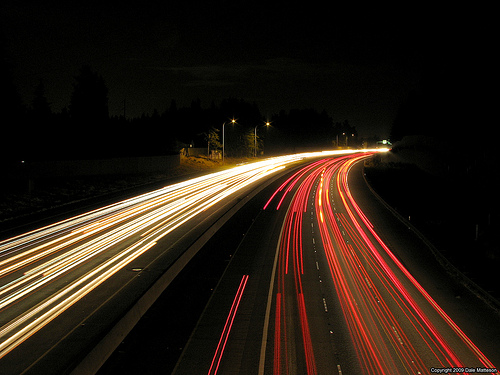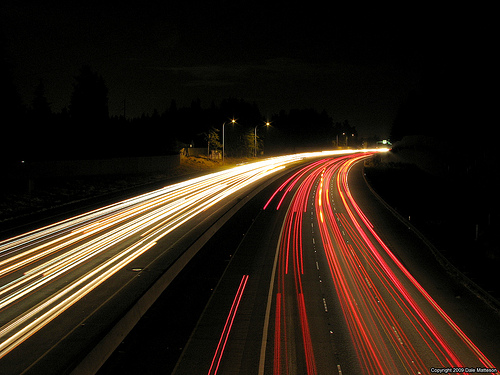 After a few months in Los Angeles, the freeway seemed terrifying rather than exhilarating.Photo: Dan MattesonOne Wednesday morning a couple of weeks back, I woke up, looked outside my kitchen window and noticed something weird. My car was missing from the spot in the driveway where it had been parked for two days.
After a few months in Los Angeles, the freeway seemed terrifying rather than exhilarating.Photo: Dan MattesonOne Wednesday morning a couple of weeks back, I woke up, looked outside my kitchen window and noticed something weird. My car was missing from the spot in the driveway where it had been parked for two days.
I was sure it had been in its usual place before I went to bed. But there it was, or rather, there it wasn’t: an empty spot where my dark gray 1992 Honda Accord had sat night after night since I moved into this place. I thought I was hallucinating. I was distraught. I had just spent $600 updating some parts. And I loved my little car. It was a gift from my family, once owned by my uncle’s mother, who had died suddenly.
When I first got the car, I wanted nothing more than to drive it. After having lived carless for over 15 years in New York and Seattle, it was a odd and giddy feeling to have the freedom to be able to go anywhere I wanted, whenever I wanted, not having to rely on public transportation or my own two legs.
With car ownership, however, came a nagging suspicion that I was on the wrong side of a Big Issue. My purist environmentalist friends were sure about it: Anyone who gets angry about the wars over oil, they told me, can’t have a car and a clean conscience at the same time.
I didn’t know if it was so simple. I had always been amused by New Yorkers who were so smug about their lack of car ownership — and then would hail numerous taxis over the course of a week, or hop on a plane for a whimsical weekend in Puerto Rico. Unless you only walk or bike, you are not in perfect harmony with the environment in the world of transportation.
And I have an embarrassing and very un-PC confession: I don’t like public transportation. I like it in theory — when it works and you get from way downtown to the other side of the city in a jiffy, you feel smarter than everyone else.
I like it better still when it is empty. When there are no men flashing you their penises, no obnoxious, inane conversations to drown out, no body odor to smell, no standing and lurching and stepping on toes during rush hour, no hassling by panhandlers or confrontational teenagers, no seemingly mentally imbalanced types who choose to sit next to you when the whole train is empty, no loud headphones — no, no, no. No to the crush of humanity. In a car, you’re in your own bubble, talking to your friends (Bluetooth only), listening to your music. The only weird smell or annoying conversation you have to endure is your own.
On the other hand, even in my new bubble, I soon discovered new irritations — ones I had long forgotten as I taxied and subwayed my way around New York. Drivers who go 20 miles over the speed limit. Drivers who fly from the far right lane to the far left in a single bound, as if they were on their way to a stunt driver audition. Drivers who ride your bumper on the freeway. Drivers who hit on you in traffic. And the worst — distracted drivers who have taken distraction to a new level. Drivers texting, reading, talking, putting on makeup, Tweeting. That old crush of humanity again. Humanity in bubbles, but still.
The more I drove that little gray Honda around my new home, the more I started to remember just how complicated cars can be. When I was growing up in Las Vegas, it was more simple. In the ‘80s and ‘90s, there was no discussion of carbon footprints or gas prices — and no public transportation. In Vegas, driving long distances was a given. If you were under 21, you weren’t allowed in the casinos, and so one of the only activities for local youth was to drive up and down the Strip, pumping the stereo, cruising.
During the end of my run in Vegas, I had started to develop an uneasy relationship with driving. Once, I had looked forward to getting in the car and driving long distances, particularly that stretch between Las Vegas and Los Angeles on Interstate 15 — the desert sky and tumbleweeds, the epic pink and orange sunsets cresting over the mountains, the right music picked as a soundtrack. But for some reason, I had become twitchy when behind the wheel: flinching at sudden movements, jumping at people making a turn from oncoming traffic.
The last month I lived there, I was just off the Strip near the mall where I worked, and I did a 360-degree flameout in the center of the road. I pulled over and cursed. I wanted to live somewhere where I would never have a car again, I told myself. I succeeded for 15 years.
By the time I had moved to Los Angeles, I had pushed those negative experiences far down in my memory. I immediately took a road trip to Vegas. When my cousin visited, I insisted I drive us down to San Diego, because I could. I wanted to drive everywhere, anywhere.
Strangely, slowly, this started to change. Soon into my relocation, I had decided that driving on any major holiday, like the Fourth of July or New Year’s Eve, was a death wish, and I didn’t venture out of my immediate neighborhood. The one time I broke my rule, I was nearly killed on a freeway by a fast-approaching pickup truck outfitted with monster-sized wheels, and a drunk driver who pulled behind me with such ferocity it seemed he would just run me over, rather than get in the next lane. On the second trip I made back from visiting Vegas, my car was being thrown around by 60-mile-an-hour winds I had not anticipated. It made driving behind the semis at 80 miles an hour terrifying.
I now white-knuckle it on the freeway — if I even make it up the on-ramp. Trips to Vegas have been delayed indefinitely. I never visit friends in far-flung parts of the city. I drive so infrequently, I can go a month before having to refill my tank.
Because I work from home, and because I chose my apartment based on the walkability of the neighborhood, I can go for days without using the car. I can walk to the movies, the grocery store, the farmers market, restaurants, and bars in the immediate vicinity. I walk distances most Angelenos wouldn’t think twice about driving. And, recently, I had profiled actor Vincent Kartheiser for The New York Times, about how he only got around using public transportation in Los Angeles. It can be done, but I don’t necessarily want to do it myself.
When my car got stolen, I stood in my empty driveway and felt a pang in my chest. I could see the little thing in my mind’s eye, its grey interior, my little pillow which boosted me up (I’m 4 foot 11 inches tall — and a quarter), the low-slung dashboard. I felt powerless without it, like a child who needed to rely on grownups to drive me around. I keep staring at the empty spot thinking maybe if I stare long enough, it will reappear.
The night the car was stolen, I walked across to the center of the neighborhood where I live and wallowed in self-pity. I drank two martinis and became an inconsolable mess. I wasn’t just crying for the loss of the car. Overwhelmed by my friends’ kindness, I was freaking out over the financial problems the situation posed. And I was lamenting the loss of what had seemed so much like freedom. A woman came over and asked me what was wrong. I mumbled about the car.
“It’s going to be OK,” she said with certainty, and smiled, “It is just a thing.”
If only it was that easy.
Addendum: After contemplating the possibility of having to buy a new car, or even, going a few months without one, the inconceivable happened — the car was found, stripped only of its ancient AM/FM cassette radio — and delivered more intact that I anticipated (Hondas from that decade are routinely stripped for parts). I was hap
py to see the old girl, but sad that she’d been so violated. We had both been taken for a ride — but for us, there was no “joy” in it.



